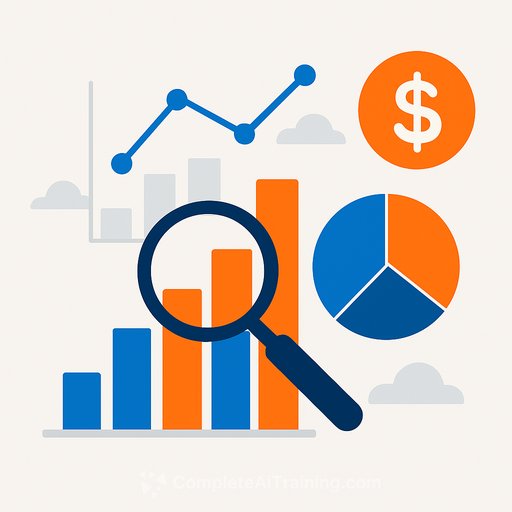The Quiet Shift in Finance: Continuous Assurance and the Autonomous Close for MSEs
Finance teams in midsize enterprises are moving past manual grind. Agentic AI is giving systems the ability to monitor, decide, and act with minimal intervention. Two capabilities lead the shift: continuous assurance and the autonomous financial close. The tech is here, practical, and changing how teams operate, scale, and lead.
Continuous Assurance: Real-Time Confidence, Not Just Compliance
Continuous assurance uses AI and automation to monitor financial data, controls, and transaction integrity as activity occurs-not just at month-end. It replaces periodic checks with always-on validation. For MSEs facing rising volumes, multi-entity structures, or stricter oversight, this means catching issues as they happen instead of during audits or close cycles.
It also strengthens governance. Embedding controls into daily workflows helps maintain compliance without slowing the business. As scrutiny increases, proactive oversight becomes a strategic advantage.
Why leading finance teams are paying attention
- Identifies risks early-before they become costly problems.
- Cuts audit prep and reduces manual controls testing.
- Frees capacity for analysis, planning, and decision support.
Autonomous Close: From Manual to Managed
The autonomous close uses AI agents to run and coordinate close activities-journal entries, reconciliations, variance analysis, and reporting. Agents work in the background, clear routine discrepancies, flag exceptions, and surface insights for review. For MSEs, that means faster, more accurate, and less resource-heavy close cycles-without late-night fire drills or spreadsheet sprawl.
Why leading finance teams are paying attention
- Shorter close cycles with consistent execution.
- Better accuracy and fewer surprises.
- Real-time visibility into financial health so leaders can act sooner.
Autonomous close also scales. As you add entities, products, or acquisitions, AI-driven processes adapt without a matching increase in headcount or complexity. Finance keeps control as the business grows.
Why Finance Leaders Are Leaning In
These are not simple process tweaks. They are force multipliers for lean teams: react faster to market shifts, scale without adding headcount, and focus on insight instead of input. With continuous assurance and an autonomous close, finance moves from reporting what happened to influencing what happens next.
ERP Updates: Where Innovation Is Happening
Sage Intacct
- Close Workspace: Centralizes tasks, flags bottlenecks, and recommends next steps.
- Continuous Assurance: Automates data entry and orchestrates workflows with real-time visibility.
- Enhanced AP Automation: Streamlines purchasing through payment to cut manual effort.
- Cash Flow AI: Predicts liquidity needs and recommends payment strategies.
- Sage Copilot: A generative assistant for contextual insights and simpler execution.
- Copilot Close: Automates reconciliations, flags anomalies, and guides users through the close.
- Upcoming Wave Releases: A roadmap for systems that reason, decide, and act with minimal input.
- AI Trust Label: Transparency into privacy, bias mitigation, data usage, and ethical safeguards.
Microsoft Dynamics 365 Finance
- Account Reconciliation Agent: Spots mismatches between subledgers and the GL, recommends corrective actions in real time.
- Copilot-driven reconciliation: Replaces static reports with dynamic exception handling and resolution tracking.
- Multi-ledger automation: Supports global compliance with shared hierarchies and transparent audit trails.
Oracle NetSuite
- SuiteAnalytics + GenAI: Build dashboards and surface insights from natural language queries.
- Autonomous Close Enhancements: Exception tools that flag anomalies and suggest fixes across journals and transactions.
- Embedded Oracle AI: Automated narratives, variance analysis, and predictive insights across planning and reporting.
For context on continuous auditing and monitoring concepts, see the AICPA overview. For AI risk and governance guidance, review the NIST AI Risk Management Framework.
How to Implement Agentic AI Without a Full Overhaul
You don't need to rip and replace. Most ERPs offer modular capabilities you can switch on. Start where friction is highest-reconciliations, AP workflows, or close tasks-then expand.
- Map the current close and control process; highlight delays, rework, and handoffs.
- Pick one or two quick wins with clear ROI (e.g., bank recs, intercompany, AP exceptions).
- Baseline metrics (close days, exception rate, audit hours) before you pilot.
- Pilot with production-grade data quality, clear owners, and human-in-the-loop review.
- Embed controls into daily workflows; log every decision and change for auditability.
- Define escalation paths for exceptions and thresholds for auto-resolution.
- Establish model monitoring: drift checks, bias reviews, and periodic control testing.
- Train the team on new workflows and accountability; iterate based on measured results.
What Good Looks Like
- Close time reduced by 30-50% with stable quality.
- High percentage of auto-reconciled accounts and transactions.
- Exception rates trending down; faster mean time to resolution.
- Audit prep hours cut; evidence stored and searchable.
- Real-time control coverage with fewer manual tests.
- Sharper forecast accuracy and stronger variance explain rates.
The Bottom Line
Agentic AI is moving from pilots to practical deployment. For MSEs, continuous assurance and an autonomous close improve control, speed, and clarity-so teams spend less time fixing and more time advising.
If you're building skills and playbooks for finance AI, this curated list may help: AI tools for finance.
Your membership also unlocks:





